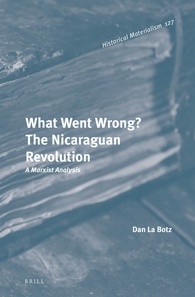Dan La Botz, Murphy Institute – City University of New York (CUNY)
This volume is a valuable re-assessment of the Nicaraguan Revolution by a Marxist historian of Latin American political history. It shows that the FSLN (‘the Sandinistas’), with politics principally shaped by Soviet and Cuban Communism, never had a commitment to genuine democracy either within the revolutionary movement or within society at large; that the FSLN’s lack of commitment to democracy was a key factor in the way that revolution was betrayed from the 1970s to the 1990s; and that the FSLN’s lack of rank-and-file democracy left all decision-making to the National Directorate and ultimately placed that power in the hands of Daniel Ortega. Pursuing his narrative into the present, La Botz shows that, once their would-be bureaucratic ruling class project was defeated, Ortega and the FSLN leadership turned to an alliance with the capitalist class.
Biographical note
Dan La Botz is the author of ten books on labour unions, social movements and politics in the United States, Mexico, and Indonesia. He earned a Ph.D. from the University of Cincinnati, was a Fulbright scholar in Mexico, and currently teaches in the colleges of the City University of New York and in the Labour Studies program of the Murphy Institute. He is a co-editor of New Politics and has been for more than twenty years the editor of Mexican Labor News and Analysis.
Readership
What Went Wrong? The Nicaraguan Revolution: A Marxist Analysis will be of interest to Latin Americanists, to students of the Communist movement, and to the general reader interested in world events. Professors of Latin American studies may find it useful as a textbook for their classes.
Reviews
“Against a rich backdrop of Nicaraguan political-economic history, Dan La Botz’s powerful and important new book interrogates the Nicaraguan revolution and its afterlives. Class struggle – understood in all of its economic, political, and ideological complexity – is at the heart of this bold and original account. What Went Wrong? is challenging and provocative in the best sense. Few old truths are left untouched.”
– Jeffery R. Webber, author of The Last Day of Oppression, and the First Day of the Same: The Politics and Economics of the New Latin American Left
“This is an indispensable, well-written history of the Nicaraguan revolution of 1979. What led to it? What did it accomplish? What went wrong and why? Dan La Botz analyzes these questions with intelligence and passion from a socialist and democratic perspective. A must read for anyone interested in the fate of one of the more important twentieth century Latin American revolutions.”
– Samuel Farber, author of The Politics of Che Guevara: Theory and Practice, Haymarket Books.
“When an urban uprising overthrew the Somoza dictatorship in 1979 there seemed hope for a more pluralist and democratic revolution. But in little more than a decade it all lay in ruins, leaders corrupted by wealth, the FSLN defeated, and neoliberal policies the order of the day. In What Went Wrong? Dan La Botz provides not only a history of the background, triumph and ultimate failure of the Sandinista revolution, but an insightful analysis of the roots of this failure. To be sure the US-backed Contra war and embargo undermined the economy and put limits on what the new leaders could do. Yet, as La Botz shows, there was a contradiction within the revolution itself—something in the politics and practice of the FSLN that crippled the democratic promises. Despite the talk of pluralism, the politics of the FSLN were shaped by their own embrace of the bureaucratic model of Cuba. The FSLN itself remained a small elite organization and the new mass organizations of workers and peasants were controlled from the top. While the FSLN had mass support for some time, the sort of mass initiative from below that might have brought a genuinely new model of revolution was stifled. In the end Nicaragua got neither a new model, nor Cuba, but neoliberal austerity. What Went Wrong? is an important contribution to our understanding not only of what happened in Nicaragua, but of what a genuine democratic socialist revolution of the future could be.”
– Kim Moody
Table of contents
Acronyms
Preface: A Marxist Analysis
Acknowledgements
Introduction: What Happened to the Nicaraguan Revolution?
1. Nicaragua: A Nation but Not a State (From the Beginning to 1893)
2. The Struggle to Construct a Sovereign State: Zelaya and Sandino (1893–1932)
3. The Somoza Dynastic Dictatorship (1932–61)
4. The Founding of the Sandinista Front for National Liberation (1962–78)
5. The Sandinistas Revolution (1979)
6. The Sandinistas in Power (1979–84)
7. The Sandinistas and the Contra War (1985–90)
8. Violeta Chamorro: A New Ruling Class, a New State, a New Economy (1990–6)
9. Alemán and Bolaños: Corruption in Power (1995–2006)
10. The Ortega Government (2006–)
Epilogue: Results and Prospects
Bibliography
Index

